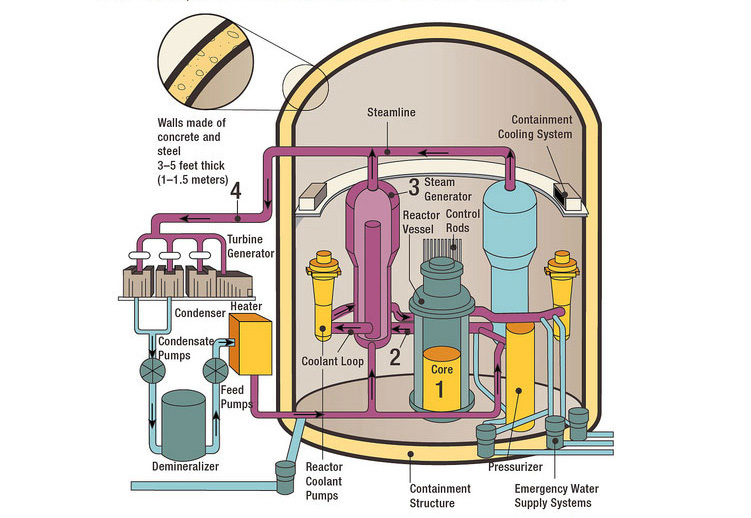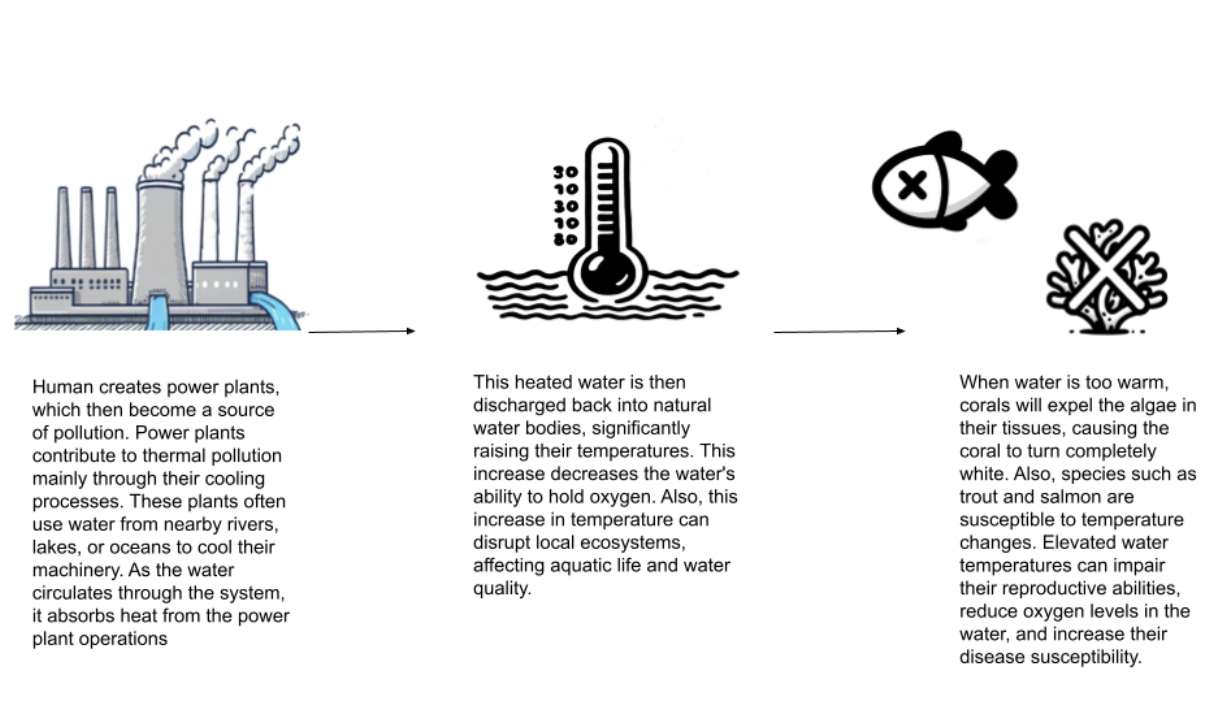IB Syllabus focus:
‘Low-carbon, steady electricity after high build costs; drawbacks include uranium mining impacts, thermal pollution, accident risk, and long-lived radioactive waste requiring indefinite storage.’
Nuclear power presents both opportunities and challenges for societies. It is a low-carbon energy source but raises issues of cost, waste, safety, and long-term environmental sustainability.
What is Nuclear Power?
Nuclear power generates electricity through nuclear fission, where atoms of uranium or other fissile materials are split to release heat, which drives turbines to produce electricity.
Nuclear fission: The process in which the nucleus of a heavy atom splits into smaller nuclei, releasing energy, heat, and neutrons.
Nuclear energy currently contributes to global electricity supplies and is valued for its steady output compared with intermittent renewables like wind or solar.

Diagram of a pressurized-water reactor showing the reactor vessel, primary coolant loop, steam generator, turbine-generator, condenser and containment. It illustrates how heat from fission transfers via a closed primary loop to produce steam in a separate secondary loop, supporting continuous base-load power. Labels may include safety-related systems beyond the syllabus focus, but they aid orientation. Source.
Advantages of Nuclear Power
Low Carbon Emissions
Nuclear plants emit minimal carbon dioxide during operation.
This makes them a strategic option for reducing greenhouse gas emissions compared with fossil fuels.
Nuclear energy supports international commitments to climate change mitigation, such as the Paris Agreement.
Reliable Electricity Supply
Provides steady base-load power not dependent on weather or time of day.
Helps stabilise energy grids when demand is high.
Complements renewable energy sources, which are variable in supply.
Energy Security
Countries with nuclear programmes can reduce reliance on imported fossil fuels.
Expands energy independence, especially for nations without domestic oil, gas, or coal reserves.
Drawbacks of Nuclear Power
High Build Costs
Nuclear reactors require enormous upfront investment.
Construction timelines are long, often extending over a decade.
Decommissioning plants at the end of their lifespan also incurs substantial financial costs.
Uranium Mining Impacts
Mining uranium can lead to habitat destruction, radioactive contamination, and health hazards for workers.
Extraction often occurs in politically sensitive regions, leading to concerns about supply stability.
Thermal Pollution
Nuclear plants release heated water into rivers, lakes, or seas.
This can disrupt aquatic ecosystems by reducing oxygen levels and altering habitats.

Simplified schematic of thermal pollution from a power station’s cooling system, showing intake water, heated discharge and a downstream thermal plume. It conveys how elevated temperatures can alter dissolved oxygen and stress aquatic life. The diagram is general to power plants but directly applies to nuclear stations using once-through or cooling-tower systems. Source.
Accident Risk
While rare, accidents like Chernobyl (1986) and Fukushima (2011) highlight potential dangers.
Risks include large-scale contamination, long-term exclusion zones, and health consequences for nearby populations.
Long-lived Radioactive Waste
Spent nuclear fuel remains hazardous for thousands of years.
Safe, indefinite storage solutions are difficult and controversial.
Current strategies include deep geological repositories, but these face public opposition and technical uncertainties.
Radioactive waste: Materials from nuclear processes that emit harmful radiation and require long-term management to avoid exposure to humans and ecosystems.
Trade-offs and Sustainability
Balancing Benefits and Risks
Nuclear power reduces emissions but carries unique environmental and safety costs.
Policymakers must weigh climate benefits against hazardous waste management and accident potential.
Intergenerational Responsibility
Waste storage and decommissioning leave challenges for future generations.
Ethical debates question whether current benefits justify long-term environmental risks.
Role in Energy Transition
Some nations see nuclear power as a bridge technology until renewable energy capacity and storage improve.
Others reject it due to unresolved waste issues and high investment demands.
Factors Influencing National Choices
Economic Factors
Wealthier nations may afford the initial costs and long-term waste management.
Developing nations often struggle to justify nuclear investment compared to cheaper alternatives.
Political and Social Factors
Public attitudes shape energy policy. Countries with strong anti-nuclear movements may phase out reactors, as seen in Germany.
Others, like France, continue investing due to nuclear’s central role in their energy strategy.
Environmental Factors
Nations vulnerable to climate change impacts may prioritise low-carbon nuclear power.
Conversely, those with seismic risks or limited cooling water supplies may consider nuclear unsuitable.
Key Trade-offs Summarised
Advantages: Low carbon, reliable output, energy independence.
Drawbacks: High cost, uranium mining damage, thermal pollution, accident risk, radioactive waste.
The decision depends on balancing immediate energy needs with long-term environmental sustainability.
FAQ
Nuclear plants require substantial cooling to prevent overheating of reactors and turbines. Large water bodies provide a steady source for cooling systems.
Discharged water is typically warmer than intake water, which can lead to thermal pollution. To minimise impacts, plants often use cooling towers or regulate discharge flows.
Radioactive waste is divided into categories based on activity level and longevity.
Low-level waste: contaminated tools, clothing, medical items; often disposed in near-surface facilities.
Intermediate-level waste: resins, chemical sludge, reactor components; requires shielding.
High-level waste: spent nuclear fuel and reprocessing residues; requires deep geological storage.
Repository safety depends on:
Stable geology with minimal seismic activity.
Isolation from groundwater flows.
Multiple engineered barriers such as metal canisters and clay backfill.
These factors aim to prevent leakage of radionuclides into the biosphere over thousands of years.
Unlike explosions or oil spills, nuclear accidents release radiation that remains hazardous for decades or centuries.
Radiation can cause long-term contamination, health effects such as cancer, and create exclusion zones where human habitation is impossible.
Governments use strategies such as:
Transparent communication of risks and safety measures.
Independent regulatory oversight.
Community involvement in decision-making for waste storage sites.
Trust is fragile and often influenced by past accidents, making social acceptance as critical as technical safety.
Practice Questions
Question 1 (2 marks)
Define the term radioactive waste and state why it presents a challenge for long-term environmental management.
Mark Scheme
1 mark for correctly defining radioactive waste as material from nuclear processes that emits harmful radiation.
1 mark for explaining the challenge, e.g., hazardous for thousands of years, requiring safe indefinite storage, or risk of contamination if not managed.
Question 2 (5 marks)
Evaluate the trade-offs of nuclear power as an energy source by discussing both one advantage and one disadvantage.
Mark Scheme
1 mark for identifying a valid advantage (e.g., low carbon emissions, reliable base-load electricity, energy security).
1 mark for describing the advantage with detail (e.g., minimal CO2 during operation supports climate change mitigation).
1 mark for identifying a valid disadvantage (e.g., radioactive waste, accident risk, thermal pollution, high construction costs, uranium mining impacts).
1 mark for describing the disadvantage with detail (e.g., waste remains hazardous for thousands of years and storage is controversial).
1 mark for evaluative element — recognising the balance between benefits and drawbacks (e.g., while nuclear is low-carbon, the unresolved waste issue limits its sustainability).

